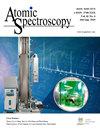临床金属组学:用HPLC-ICP-MS分析砷中毒患者尿液中的砷形态
IF 2.3
2区 化学
Q1 SPECTROSCOPY
引用次数: 2
摘要
临床金属学是金属学的一个分支,主要研究临床尿液、血液和组织样本中的金属学。由于临床上对砷中毒的诊断主要基于尿液中总砷的浓度,不同物种对砷的毒性差异很大。分析尿中总砷超标的砷形态可为精准治疗提供依据。也可以用来了解砷中毒患者在接受二巯基丙烷磺酸钠治疗后,体内砷的命运。本研究建立了HPLC-ICP-MS法测定砷中毒患者尿液中砷的种类。用所建立的方法检测尿样,用20 mmol/L EDTA-2Na简单稀释即可直接检测。砷形态浓度在1.0~100.0 ng/mL范围内,线性相关系数均大于0.99996。加样回收率在92.4% ~ 109.0%之间。浓度和保留时间(n = 3)的精密度分别小于3.0%和0.3%,检出限在1.42 ~ 1.86 ng/mL之间。该方法可应用于健康人、砷中毒治疗患者和砷中毒诊断患者尿液中的砷形态。本文章由计算机程序翻译,如有差异,请以英文原文为准。
Clinimetallomics: Arsenic Speciation in Urine from Patients With Arsenism by HPLC-ICP-MS
Clinimetallomics is proposed as a branch of metallomics that focuses on the study of the metallome in clinical samples of urine, blood, and tissues. As the clinical diagnosis of arsenic poisoning is mainly based on the concentration of total arsenic in urine, the toxicity of arsenic varies greatly in different speciation. Analysis of arsenic speciation with excessive total arsenic in urine can provide a basis for precise treatment. It can also be used to understand the fate of arsenic in the body of patients with arsenic poisoning after treatment with sodium dimercaptopropane sulfonate. In this study, a HPLC-ICP-MS method was established for the determination of arsenic species in urine samples from patients diagnosed with arsenism. Use the established method to detect urine samples, which can be directly assayed after simple sample dilution with 20 mmol/L EDTA-2Na. With the concentration of arsenic speciation in the range of 1.0~100.0 ng/mL, the linear correlation coefficient was higher than 0.99996. The recoveries were between 92.4% and 109.0%. The precision of the concentration and retention time (n = 3) were less than 3.0% and 0.3%, respectively, and the detection limit was between 1.42 ng/mL and 1.86 ng/mL. This method can be applied to arsenic speciation in the urine of healthy people, in patients treated for arsenic poisoning, and in patients diagnosed with arsenism.
求助全文
通过发布文献求助,成功后即可免费获取论文全文。
去求助
来源期刊

Atomic Spectroscopy
物理-光谱学
CiteScore
5.30
自引率
14.70%
发文量
42
审稿时长
4.5 months
期刊介绍:
The ATOMIC SPECTROSCOPY is a peer-reviewed international journal started in 1962 by Dr. Walter Slavin and now is published by Atomic Spectroscopy Press Limited (ASPL). It is intended for the rapid publication of both original articles and review articles in the fields of AAS, AFS, ICP-OES, ICP-MS, GD-MS, TIMS, SIMS, AMS, LIBS, XRF and related techniques. Manuscripts dealing with (i) instrumentation & fundamentals, (ii) methodology development & applications, and (iii) standard reference materials (SRMs) development can be submitted for publication.
 求助内容:
求助内容: 应助结果提醒方式:
应助结果提醒方式:


